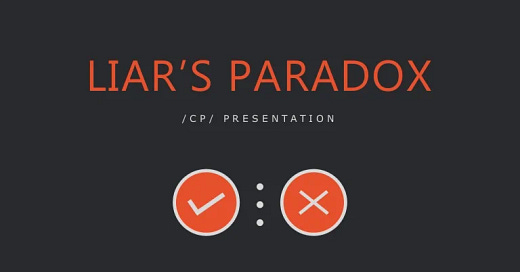My Tentative Solution To The Liar's Paradox
I'm not positive if it works but it makes sense intuitively
The liar’s paradox involves the following sentence.
“This sentence is false.”
Is that sentence true or false? If it’s true that it’s false then it’s false but if it’s false that it’s false then it’s true. Thus, it would have to be simultaneously true and false or neither. These both seem like bad options.
My solution is the following. Consider the following sentence
Is is not not not not not not not not not not not……. the case that I exist, where the number of nots is infinite. Is that sentence true or false? Well, neither, it doesn’t refer to anything. 2 nots cancel out, but infinity is neither even nor odd, so an infinite number of nots would be indeterminate in meaning between I exist and it’s not the case that I exist.
The liar’s paradox is similar. In the liar’s paradox, when it says this sentence is false, the “this sentence,” in question is “this sentence is false.” Thus, it means “this sentence is false is false,” but this sentence is once again “this sentence is false,” so it means “this sentence is false is false is false…” with an infinite number of is falses. Such a sentence has the same truth value as a the statement I’m not not not not not not not not not not not not the author of this blog. Such a statement refers to nothing—an infinitely long sentence with alternating meanings has no truth value. Infinity is neither even nor odd.
This also explains why the sentence “this sentence is true,” is not paradoxical. The sentence “not not not not not not not not not not not…P,” for an infinite number of P’s is neither true nor false, but the statement “it is the case that it is the case that it is the case that it is the case that it is the case that…P,” would be true because it’s meaning is not infinitely alternating between two opposite statements.
Thoughts?




Residual puzzle: so then you're view is that 'This sentence is false' (call this sentence The Liar) is not false, but has no truth value. So you think the Liar is not false. So it's false to say that it's false. But what the Liar says *is* that it is false, so it's false after all. Where did this reasoning go wrong?
Alternative Solution: Every statement of fact contains an implicit "It is true that" so the statement "The Sky is Blue" is equal to the phrase "It is true that the Sky is blue" and the phrase "It is false that the Sky is Blue" is equal to the phrase "It is true that it is false that the Sky is blue".
So we can say that the phrase "This sentence is false", as a sentence making an assertion of fact, is equal to "It is true that this sentence is false" - or alternatively "This sentence is true and false", which is obviously false.